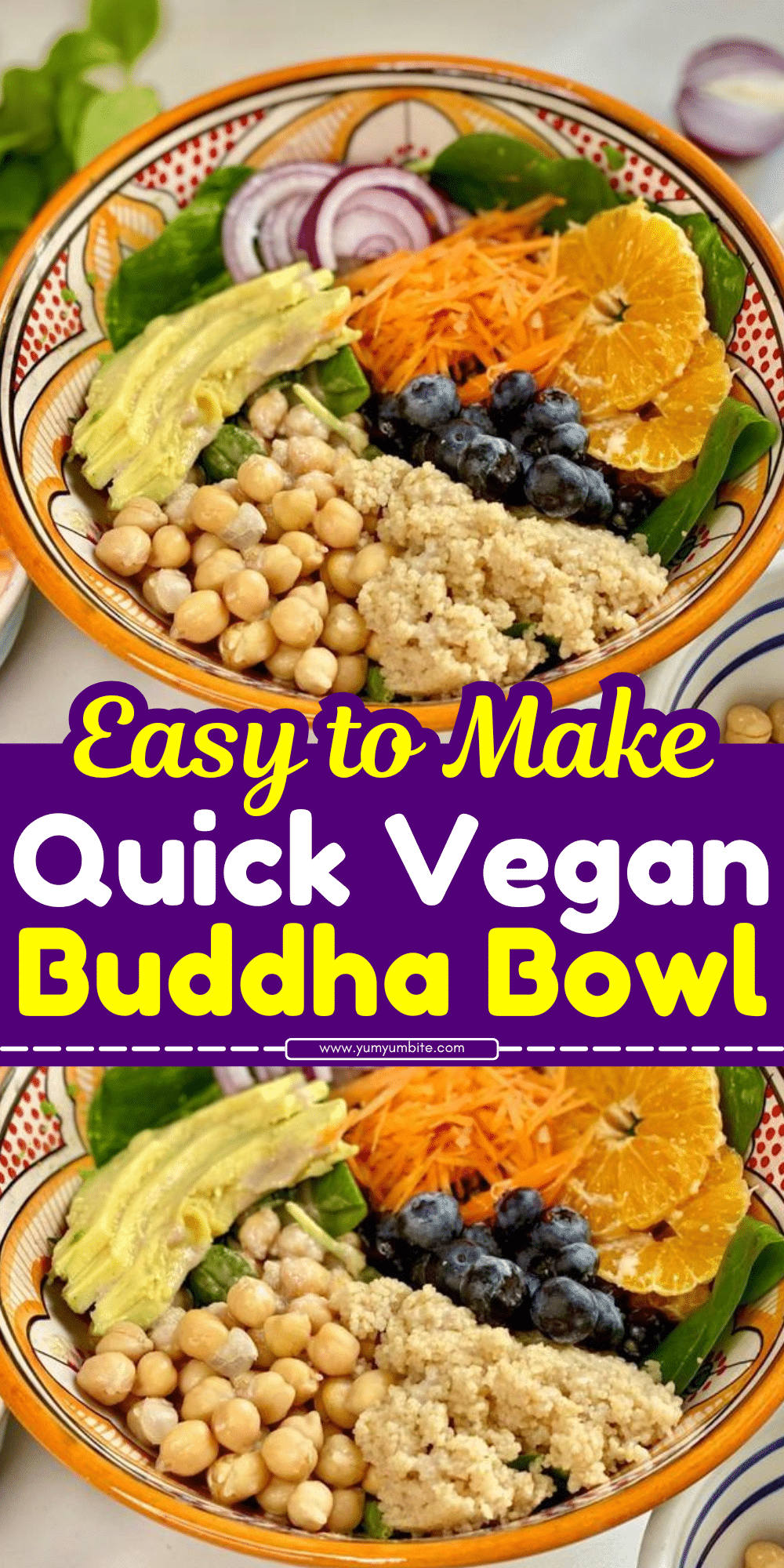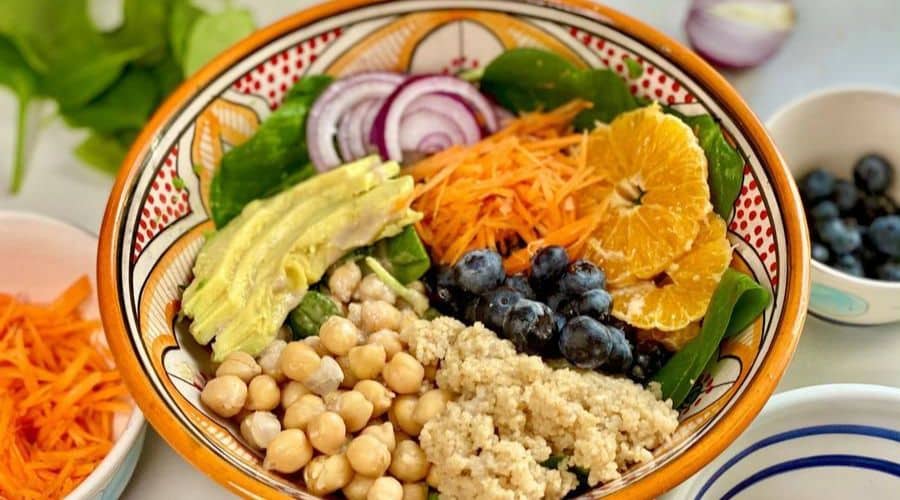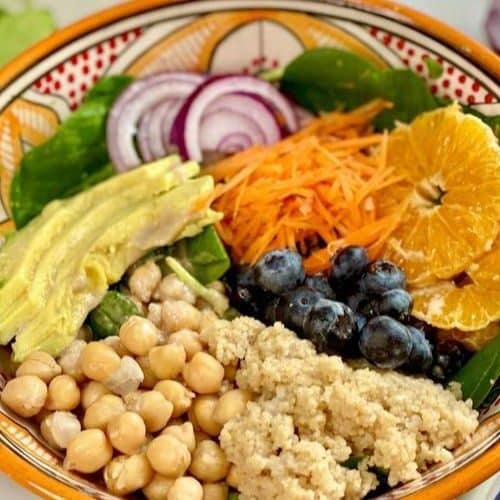All products are selected by our editorial team for quality. If you buy through our links, we may earn a small commission at no extra cost to you.
A Vegan Buddha Bowl is a vibrant, nutrient-packed meal that combines a variety of plant-based ingredients into one colorful, satisfying dish.
The beauty of this bowl lies in its versatility—each ingredient can be tailored to fit personal taste preferences, seasonal produce, or dietary needs.
From a wholesome grain base to a variety of roasted or raw vegetables, protein-packed legumes, and creamy dressings, a Buddha bowl offers everything you need to nourish your body.
Whether you’re looking for a filling lunch, a wholesome dinner, or a make-ahead meal for the week, the vegan Buddha bowl checks all the boxes.
It’s as delicious as it is nutritious, bringing together a balance of flavors, textures, and colors in every bite.

Why Choose a Vegan Buddha Bowl?
Opting for a Vegan Buddha Bowl means embracing a plant-based lifestyle that is not only good for your health but also beneficial to the planet.
A vegan diet can lower your risk of chronic diseases, such as heart disease, diabetes, and high blood pressure, due to the abundance of fiber, vitamins, and antioxidants found in plant-based foods.
By using wholesome ingredients like grains, vegetables, and plant-based proteins, a Buddha bowl offers a powerhouse of nutrients in one meal.
Beyond the health benefits, a vegan Buddha bowl is an ethical choice, as it avoids animal products and focuses on sustainable, cruelty-free options.
This meal also makes a positive environmental impact by reducing the carbon footprint associated with animal agriculture.
On top of that, these bowls are incredibly customizable, allowing you to mix and match ingredients based on what’s in season, what you’re craving, or what you have in your pantry.
Whether you’re a seasoned vegan or someone simply looking to incorporate more plant-based meals into your diet, a vegan Buddha bowl is a delicious and simple way to do so.
Key Components of a Vegan Buddha Bowl
Creating the perfect Vegan Buddha Bowl starts with choosing the right components to make a well-rounded and satisfying meal.
A Buddha bowl typically consists of several key ingredients, each playing an important role in contributing to the overall flavor and nutritional profile of the dish.
1. Grains: The Base of Your Bowl
Grains serve as the foundation of your Buddha bowl.
They provide essential carbohydrates, fiber, and energy.
Common choices include quinoa, rice, farro, or barley.
Quinoa, for example, is a complete protein, meaning it contains all nine essential amino acids, making it a popular choice for plant-based meals.
Brown rice is another go-to, offering a hearty texture and nuttier flavor.
For variety, you can also use couscous or bulgur wheat.
Grains not only provide nutritional value but also set the stage for the rest of the ingredients to shine.
2. Vegetables: Color and Nutrients
The vegetables are where the Buddha bowl really comes alive.
Roasted vegetables like sweet potatoes, beets, and cauliflower provide warmth and depth, while raw vegetables like spinach, kale, cucumbers, and bell peppers add freshness and crunch.
The key is to balance flavors and textures.
Roasted veggies bring out natural sweetness, while raw veggies offer a crisp bite and an added boost of vitamins and minerals. Be sure to include a mix of colors to maximize the nutritional benefits.
3. Protein: Powering Up Your Bowl
A balanced Buddha bowl should contain a good source of plant-based protein to keep you full and satisfied.
Popular options include chickpeas, black beans, lentils, tofu, tempeh, or edamame.
These proteins can be prepared in a variety of ways, such as baking or pan-frying tofu and tempeh to add a crispy texture or seasoning chickpeas with spices for extra flavor.
Protein is essential for muscle repair and energy, making it a vital part of any vegan meal.
4. Healthy Fats: Creamy and Satisfying
Healthy fats, such as avocado, olive oil, or seeds like sunflower or pumpkin, add richness to your Buddha bowl.
They also provide long-lasting satiety and help your body absorb fat-soluble vitamins (like vitamins A, D, E, and K) from other ingredients.
A few slices of creamy avocado or a sprinkle of sesame seeds not only enhance the flavor but also contribute to a balanced, filling meal.
5. Dressings: The Finishing Touch
The dressing is where you can get creative and elevate the flavors of your Buddha bowl.
A simple tahini dressing made with lemon, garlic, and a touch of maple syrup can add creaminess and a hint of sweetness.
Alternatively, a zesty lemon-tahini or avocado-lime dressing can bring brightness to the dish.
Dressings can also be made with ingredients like soy sauce, sesame oil, and ginger to give the bowl an Asian-inspired flair. No matter the flavor profile, a well-balanced dressing ties the whole bowl together.
Step-by-Step Guide to Making a Vegan Buddha Bowl

Making a Vegan Buddha Bowl is simple, and the beauty of it lies in its versatility.
You can personalize it to fit your tastes, the season, or the ingredients you have on hand.
Here’s a step-by-step guide to create your own nutrient-packed bowl:
Step 1: Choose Your Base (Grains)
Start by selecting your base grain. Cook your chosen grain according to package instructions.
For example, quinoa typically takes about 15 minutes to cook, while rice might take a bit longer.
You can even prepare the grains in advance and store them for easy meal prep.
Once the grains are ready, fluff them with a fork for the perfect texture.
Step 2: Add Color with Vegetables
Next, it’s time to incorporate vegetables.
Choose a combination of raw and roasted vegetables to add both freshness and depth of flavor.
For roasted veggies, preheat your oven to 400°F (200°C), toss your chosen vegetables in olive oil and seasoning, and roast them for 20-30 minutes.
You can prep vegetables like sweet potatoes, cauliflower, and Brussels sprouts ahead of time.
For raw vegetables, shred carrots, slice cucumbers, or chop leafy greens like spinach or kale.
Step 3: Add Protein Power
Now, focus on your protein. If you’re using tofu, tempeh, or chickpeas, season them with your favorite spices. For tofu, try marinating and baking it for a crispy texture or pan-fry tempeh for a savory bite.
For chickpeas, roast them with paprika, garlic powder, and cumin for added flavor.
If you prefer lentils or beans, cook them until tender. Arrange the protein on top of your grains and vegetables.
Step 4: Top with Healthy Fats
Avocado is a popular option for adding healthy fats and creaminess to your bowl.
Simply slice it and arrange it neatly on top. You can also sprinkle seeds, such as sunflower or pumpkin, or add some nuts like almonds or walnuts for added texture and crunch.
Step 5: Drizzle with a Delicious Dressing
The final touch is the dressing.
Drizzle your homemade dressing over the bowl, making sure every ingredient gets a little bit of flavor.
A lemon-tahini or avocado-lime dressing is perfect for bringing all the components together, but feel free to get creative with your sauces.
Step 6: Assemble Your Buddha Bowl
Now that all your components are ready, it’s time to assemble your Buddha bowl.
Start by placing the grains at the bottom, then arrange the roasted and raw vegetables around the grains.
Add the protein and finish with healthy fats and a generous drizzle of dressing.
Garnish with herbs or seeds for extra flair. Enjoy your beautiful, nutrient-packed creation!
Tips for Customizing Your Vegan Buddha Bowl
One of the most exciting parts of a Vegan Buddha Bowl is that you can customize it to suit your tastes, preferences, or dietary needs.
Here are a few tips to make it your own:
Experiment with Different Grains
Try quinoa, farro, rice, or barley to change up the texture and flavor.
If you’re looking for a low-carb option, you can substitute grains with cauliflower rice or zucchini noodles.
Vary Your Vegetables
Add a mix of roasted, sautéed, or raw vegetables depending on your taste and the season.
For a fall-inspired bowl, opt for roasted butternut squash, Brussels sprouts, and beets.
In the summer, you might prefer a refreshing combo of cucumber, tomatoes, and avocado.
Switch Up Your Protein
While tofu and tempeh are classic options, feel free to swap them out for chickpeas, black beans, or lentils.
You can also experiment with quinoa or edamame for plant-based protein.
Get Creative with Dressings
Switch your dressing depending on the flavor profile you want.
For a spicy kick, try a Sriracha-mayo sauce, or go tangy with a mustard vinaigrette. The possibilities are endless!
Add Fresh Herbs and Toppings
Top your Buddha bowl with fresh herbs like cilantro or parsley for extra flavor.
Seeds, nuts, or even dried fruits like cranberries can add a delightful crunch and sweetness.
Conclusion: Enjoy a Delicious, Nourishing Vegan Buddha Bowl
A Vegan Buddha Bowl is more than just a meal—it’s a celebration of fresh, vibrant, and wholesome ingredients.
Packed with plant-based proteins, colorful vegetables, healthy fats, and delicious dressings, it’s the ultimate nourishing dish that can be enjoyed for any occasion.
Whether you’re preparing it for lunch, dinner, or a meal prep option, this bowl provides everything you need for a balanced, satisfying meal.
Plus, it’s completely customizable, so you can create a unique version every time based on your tastes or the season’s offerings.
So go ahead, build your bowl, and dive into the delicious world of plant-based eating with a Vegan Buddha Bowl that’s as nutritious as it is flavorful!
Frequently Asked Questions
1. Can I prepare a Vegan Buddha Bowl in advance?
Yes, you can easily prepare components of your Vegan Buddha Bowl in advance. Cook your grains, roast vegetables, and store them separately in airtight containers. When ready to assemble, just add fresh toppings like avocado and dressing.
2. How can I make my Vegan Buddha Bowl more filling?
To make your Buddha bowl more filling, focus on adding more protein (like tempeh, tofu, or beans) and healthy fats (such as avocado or nuts). You can also increase the portion of grains for a heartier meal.
3. What if I don’t like certain vegetables?
No problem! Buddha bowls are highly customizable, so feel free to swap out vegetables for your favorites. If you’re not a fan of kale, try spinach or arugula instead. Just make sure to balance the flavors and textures.
4. Can I make a Buddha bowl gluten-free?
Absolutely! Many Buddha bowl components are naturally gluten-free, such as quinoa, rice, vegetables, and plant-based proteins.
Just make sure to check any sauces or dressings for gluten-containing ingredients.
5. What are some good dressing options for a Vegan Buddha Bowl?
Some popular vegan dressings include tahini-lemon dressing, avocado-lime dressing, or a balsamic vinaigrette.
You can also make a spicy dressing with sriracha and coconut yogurt or a creamy cashew-based dressing.

Vegan Buddha Bowl
Equipment
- 1 Baking Sheet (for roasting veggies)
- 1 Medium Saucepan (for cooking grains)
- 1 Medium Bowl (for mixing dressing)
- 1 Knife (for chopping vegetables and slicing avocado)
- 1 Cutting Board (for preparing ingredients)
- 1 Spoon (for drizzling dressing)
- 1 Fork (for fluffing grains)
Ingredients
Grains (Base):
- 1 cup quinoa cooked (or any grain of choice like rice or farro)
Vegetables (Roasted & Raw):
- 1 medium sweet potato peeled and diced
- 1 cup cauliflower florets
- 1/2 cup bell pepper diced
- 1/2 cup cucumber sliced
- 1/2 cup spinach or other leafy greens
Protein:
- 1 cup chickpeas roasted
- 1/2 cup tofu or tempeh, cubed
Healthy Fats:
- 1 avocado sliced
- 2 tbsp pumpkin seeds or any seeds/nuts
Dressing:
- 3 tbsp tahini
- 1 tbsp lemon juice
- 1 tbsp maple syrup
- 1 garlic clove minced
- 1-2 tbsp water to thin the dressing, if needed
- Salt and pepper to taste
Instructions
Prepare the Grains:
- Cook your choice of grain (such as quinoa, rice, or farro) according to the package instructions. Set aside once cooked and fluff with a fork.
Roast the Vegetables:
- Preheat the oven to 400°F (200°C). Toss the diced sweet potato and cauliflower florets with olive oil, salt, and pepper. Spread them out evenly on a baking sheet and roast for 20-25 minutes, flipping halfway through, until golden and tender.
Cook the Protein:
- While the veggies are roasting, prepare your protein. If using chickpeas, drain, rinse, and toss them with olive oil, smoked paprika, salt, and pepper, then roast them on a separate baking sheet for 10-15 minutes. If using tofu or tempeh, season with salt, pepper, and your choice of spices (such as cumin or turmeric) and pan-fry until crispy.
Prepare the Dressing:
- In a medium bowl, whisk together tahini, lemon juice, maple syrup, minced garlic, and water. Adjust the consistency with more water if needed. Season with salt and pepper.
Assemble the Buddha Bowl:
- In a large bowl or plate, start with a base of quinoa (or your chosen grain). Arrange the roasted sweet potato and cauliflower, raw vegetables (cucumber, bell pepper, spinach), chickpeas, and tofu. Add slices of avocado and sprinkle pumpkin seeds on top.
Drizzle with Dressing:
- Pour the dressing generously over your assembled Buddha bowl, and give it a final seasoning of salt and pepper to taste. Serve immediately and enjoy!
Notes
- Customization: You can swap any of the vegetables for those that are in season or your personal favorites. Zucchini, roasted mushrooms, or steamed broccoli would also be great options.
- Grains: Feel free to use cauliflower rice for a low-carb option.
- Protein Options: Chickpeas, tempeh, or lentils are excellent protein choices, but you can also add edamame or black beans.
- Dressing Variations: If you prefer a spicy kick, you can add a dash of sriracha to the tahini dressing or try a creamy avocado-lime dressing.
- Storage: The ingredients (except for the avocado) can be stored separately in airtight containers for up to 3 days, making it perfect for meal prep.


